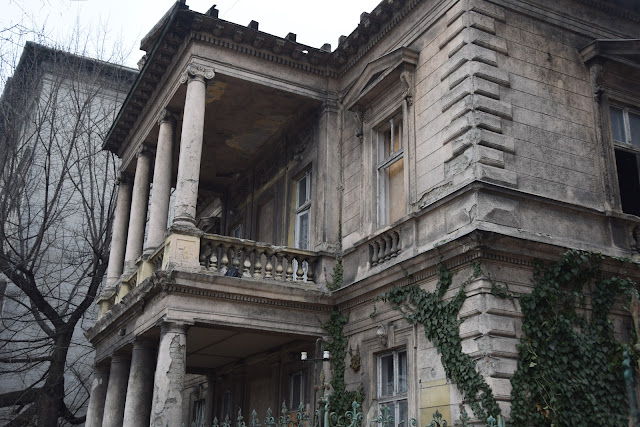This is my last post from Budapest (except for a finale with pictures of desserts also to come). I started it when we were in Budapest, but then I got a really bad cold and pretty much took to my bed for a couple of days. But I want to finish it because it also offers a kind of finale. It's just a record of our walk down one street, and its main purpose was to show the richness and diversity one can find scattered through Budapest. The street Dozsa Gyorgy ut is an important one. It runs perpendicular to Andrassy (which it meets in about its middle) and eventually parallel to Heroe's Square. But it's not different from many other streets. So here we go on a walk down Dozsa Gyorgy ut.
The picture above is of 152 and was built by Lajos Schoditsch and Bela Eberling between 1910 and 1911. It has the more geometric (rather than floral) decorations of late Art Nouveau.
.
Next up at at Dozsy Gyorgy ut 55 is the a synagogue built by Hungary's greatest architect of synagogues, Lipot Baumhorn, Built in 1908, it deteriorated after 1945 and was used first as a warehouse, then a sporting center. It now appears to be abandoned.
The Dozsa Gyorgy Synagogue resembles Baumhorn's Fabric Synagogue in Timisoara and his Great Synagogue in Szeged (which I must post pictures of). Like them, the Synagogue has rose windows and is shaped as a square.
After the Synagogue, we stumbled on a school at 136 with amazing tiles depicting children at play and learning.
The school was built between 1910 and 1911 by Erno Balasz. The facade and tiles are attributed to Karoly Kernstock, a famous Hungarian painter, but there is some dispute about this.
Next at 108 is a lovely building about which I have no information except that it would have definitely been built in the first 10 years or so in the 20th century.
Lovely gate and interesting details.
The next notable building is Dozsa Gyorgy 102, built by Samuel Revesz and Joseph Kollar in 1914. It was the home of Jeno Vida whom I wrote about earlier.
Immediately after is Dozsa Gyorgy 100 built by Imre Benes inn 1903. This lush Art Nouveau villa sits directly across the street from the neo-Classicist Museum of Fine Arts.
Further along is a house I have been watching since I first started noticing buildings. Each year is becomes more decayed and I haven't been able to find anything about it. But it must have once been very imposing, sitting as it is directly across from Varosliget, or Central Park.
Finally, or at least as far as we got, is another building at 64 by Gyula Fodor.
The facade is somewhat deteriorated. But it has many interesting details, reflecting Fodor's love of sculptural elements.
But where is the door?
Around the side, along a kind of alley.
And yes, those windows are stained glass. (Oh how much I want to see the inside!).
On top of the door.
Peeking through the glass.
Wanting to open the door.
I love these buildings so very much. First because they are beautiful, although sometimes you have to look hard to see it. But second because there is this thrill of discovery, whenever I find out who built it (and even better who lived there). I glean this information from used books and internet chases for clues. Budapest is so rich. Just one street (albeit a large and important one). It's a mosaic and a kaleidescope all at the same time.
#BudapestArchitecture
#DozsaGyorgyUt
#LipotBaumhorn
#GyulaFodor







































D--
ReplyDeleteOooooh!!!!!!!!
I looooooooove this post!!!! My favs are the school with the neat tile pictures of children, the bearded guy peaking out from behind the ivy, and the rainspot man with the spreading collar on the building by Gyula Fodor.
Very very neat--marvelous buildings and some really great photographs!!!
C.
Someone needs to write a novel with the story of that abandoned house.
ReplyDelete